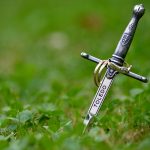In Japan, a katana is known as a nihonto if it is handmade. These frequently cost between $10,000 and $25,000 and occasionally even more.
In general, katanas are expensive, and the cost increases when one is an actual samurai katana.
Prices for “fairly traditional” items typically range between $1,000 and $4,500 compared to Chinese products.
Why is a genuine Katana so pricey?
Technically speaking, the creation of this vintage, traditionally forged Katana sword is distinguished by intricate and time-consuming steps.
These involve challenging processes like bending, rolling, and differential hardening that requires a lot of skill and knowledge to produce a flawless Katana.
Be aware that bending a katana only needs to be done once instead of a thousand times, contrary to popular belief. Rarely does it take more than fifteen? However, even with fewer folds, it is still possible to build up a sizable number of layers, frequently exceeding 32,000 layers.
The iron ore in ancient Japan was of poor quality. But because of their inventiveness, the blade makers utilized a variety of impure iron plates that were afterward refined with a flame.
The purifying process took 72 hours, and the Tatara furnace was explicitly made for this purpose. Tamahagane, the renowned traditional Katana steel, was created using this procedure.
There are various ways to forge, which adds to the essential physical characteristics of a katana. The Kobus, Sanmai, and Shoshu Kitae, for the more complex ones, are among these, starting with the most basic form. These techniques share the step of joining steel components from several harnesses together.
Blades made through fusion can keep their edges without breaking.
The process aims to create a blade with a firm edge. Additionally, a soft envelope must be present around the blade.
The idea of a soft back and a hard edge is relevant when it comes to clay and differential tempering. Additionally, it creates Japanese Hamon. The procedure is applying a clay layer over the blade.
A dense coating is required on the spine, and a thin layer is needed on edge. To help the edge cool more rapidly, it will first be heated to a temperature of roughly 750 degrees Celsius. This process yields a blade with a solid edge while keeping the entire blade flexible.
“Fake” Katana versus Real Katana
Regarding the argument over authentic vs. counterfeit katanas, some purists assert that the only genuine Nihonto katana produced in Japan costs more than $5000. Actual sword production is tightly controlled, and Japan has some of the harshest gun possession rules in the whole world. As a result, each master smith has a cap on the number of swords they can produce, which contributes to the high cost of a genuine Japanese-made Katana.
However, you can purchase high-quality reproductions in Japan for between 100 and 1000 euros. However, you must budget for a genuine Katana made of Tamahagane steel.
Let’s clarify what we mean by “genuine,” though.
If a real sword is handmade, has a natural Hamon temper line, is exceedingly sharp, well-balanced, and has a high-quality vocabulary, then you can find them for less than $5000.
It can be challenging for a novice to distinguish between a $500 and a $5000 Katana. They look similar outside, but the small features will set them apart.
Even an expert might struggle to distinguish the swords from one another, given a clear image.
Why are the costs so disparate?
The price is heavily influenced by the reputation of the blacksmith and the business that will forge the sword. It is stated that a specialist or enthusiast could identify who produced the sword and which Japanese region it came from.
Second, it may take a Japanese sword more than a year to be created utilizing Japanese steel. Real Katana swords are hard to find because there are so few Katana masters in Japan.


